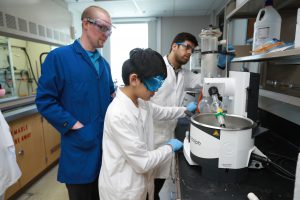12-year-old UT student creates faster, cheaper way to make pharmaceutical drugs, agricultural pesticides
May 31st, 2018 by Christine BillauLike many 12-year-olds, Daniel Liu enjoys reading books and wears t-shirts covered in cartoon characters.
Unlike most boys and girls his age, Liu has been honored at the White House for his science achievements and is now a published scientific researcher at The University of Toledo.

Daniel Liu
The Ottawa Hills High School student has been taking classes at UT for more than a year through Ohio’s College Credit Plus program.
Liu is one of three members of a UT green chemistry lab team that created a chemical reaction that results in a faster, cheaper, more environmentally friendly way to make pharmaceutical drugs and agrochemicals, such as pesticides and herbicides.
The team’s research, which was recently published in the Journal of the American Chemical Society, shows how carbon dioxide in the form of dry ice is used to break up carbon-hydrogen bonds, reactions known as C-H activation.
“We showed that we could run this reaction with many different starting materials and produce very diverse products,” said Liu, a co-author on the paper.
“When you take an unreactive carbon-hydrogen bond, which is found in most organic compounds, and break it to convert it into a new type of bond, you make new molecules more quickly and more sustainably, especially in pharmaceutical and agrochemical molecules,” said Dr. Michael Young, assistant professor in the UT Department of Chemistry and Biochemistry.
That means, much like Liu’s sky-rocketing academic journey, you skip grades or steps in the process, reducing the time and resources it takes to achieve results.
“This chemical reaction cuts up to five steps out of a process that normally takes six or seven,” Liu said. “C-H activation also improves overall synthetic efficiency. We found a way to potentially help patients, farmers and the environment when it comes to how medicine and pesticides are made.”
Dr. Mohit Kapoor, UT post-doctoral researcher in medicinal and sustainable chemistry, said Liu has demonstrated an incredible ability to learn and discover at the collegiate level.
“I now see him as a co-worker in my lab. He is a genius and a prodigy,” Kapoor said. “But I remember in the beginning thinking, ‘How could he handle all these things?’ He has proven that he has the knowledge. He can do the work properly and learns quickly.”
“While this is highly unusual, Daniel has unusual talent and great support from his parents,” Young said. “He has already taken most of the junior-level course work in the chemistry program. While he doesn’t have the emotional maturity or physical stature of an older student, he is intellectually advanced compared to his peers.”
 Young, Kapoor and Liu are the three authors of the research paper. The scientists say Liu was involved in every step of the project, investing more than 400 hours of work.
Young, Kapoor and Liu are the three authors of the research paper. The scientists say Liu was involved in every step of the project, investing more than 400 hours of work.
“Daniel made many of the starting materials for the reactions and also performed many of the key reactions. He also remade the compounds to validate that we could do this, help make enough of them to characterize them, and prove they were what we said they were,” Young said. “Plus, he helped us craft the manuscript. He went through and made suggestions on how to present our work.”
UT has filed a provisional patent on the work and the team is looking to market to pharmaceutical companies that make generic drugs.
“We’re excited about the potential to commercialize this because it is much cheaper and more easily recyclable,” Young said. “This really could be a benefit to the synthetic community.”
Liu’s passion lies in developing new pharmaceutical drugs to help people fight different diseases.
“I feel like this is the start of a career and hopefully I can do more of this research in the future,” Liu said. “I’m starting work on a couple of these projects by myself. I simply want to help people.”
Liu started high school at the age of 10.
In 2016 Liu visited the White House and met President Barack Obama after winning the national “You Be the Chemist” challenge – defeating 30,000 other students. He was the youngest ever to win the Chemical Education Foundation’s competition.
Recently, he received high honors in the National Chemistry Olympiad.
Liu also is assistant principal cellist in the University orchestra. It’s one way he has become involved in UT’s vibrant, diverse campus.
“I had an adjustment period, but this is normal to me now,” Liu said. “I feel at home here and supported in my studies. I’m trying to take advantage of all that UT has to offer so I can keep learning and growing. I want to go to graduate school. I’m also considering medical school. I want to do more stuff that changes the world and helps people.”
Christine Billau is
UT's Media Relations Specialist. Contact her at 419.530.2077 or christine.billau@utoledo.edu.
Email this author | All posts by
Christine Billau

